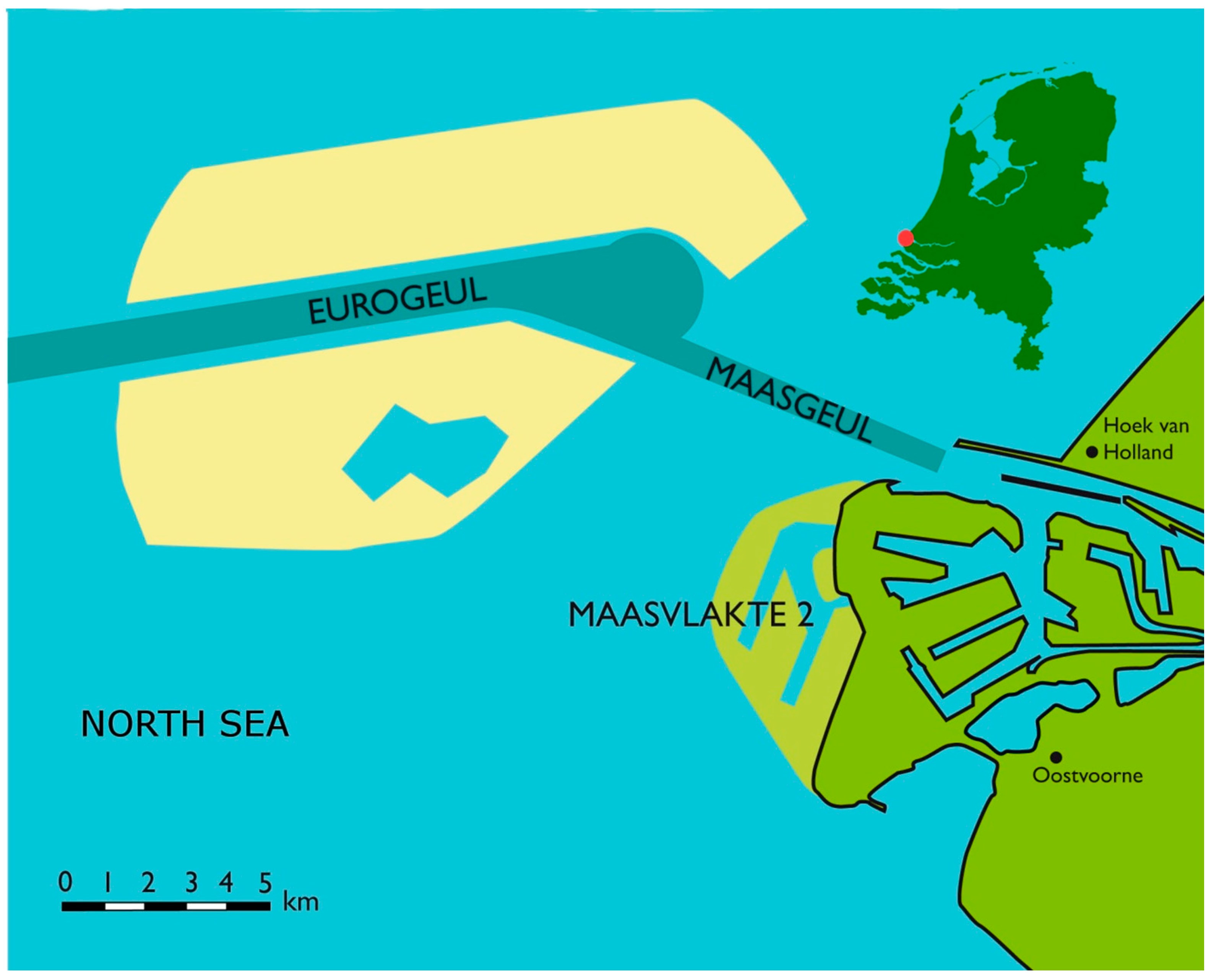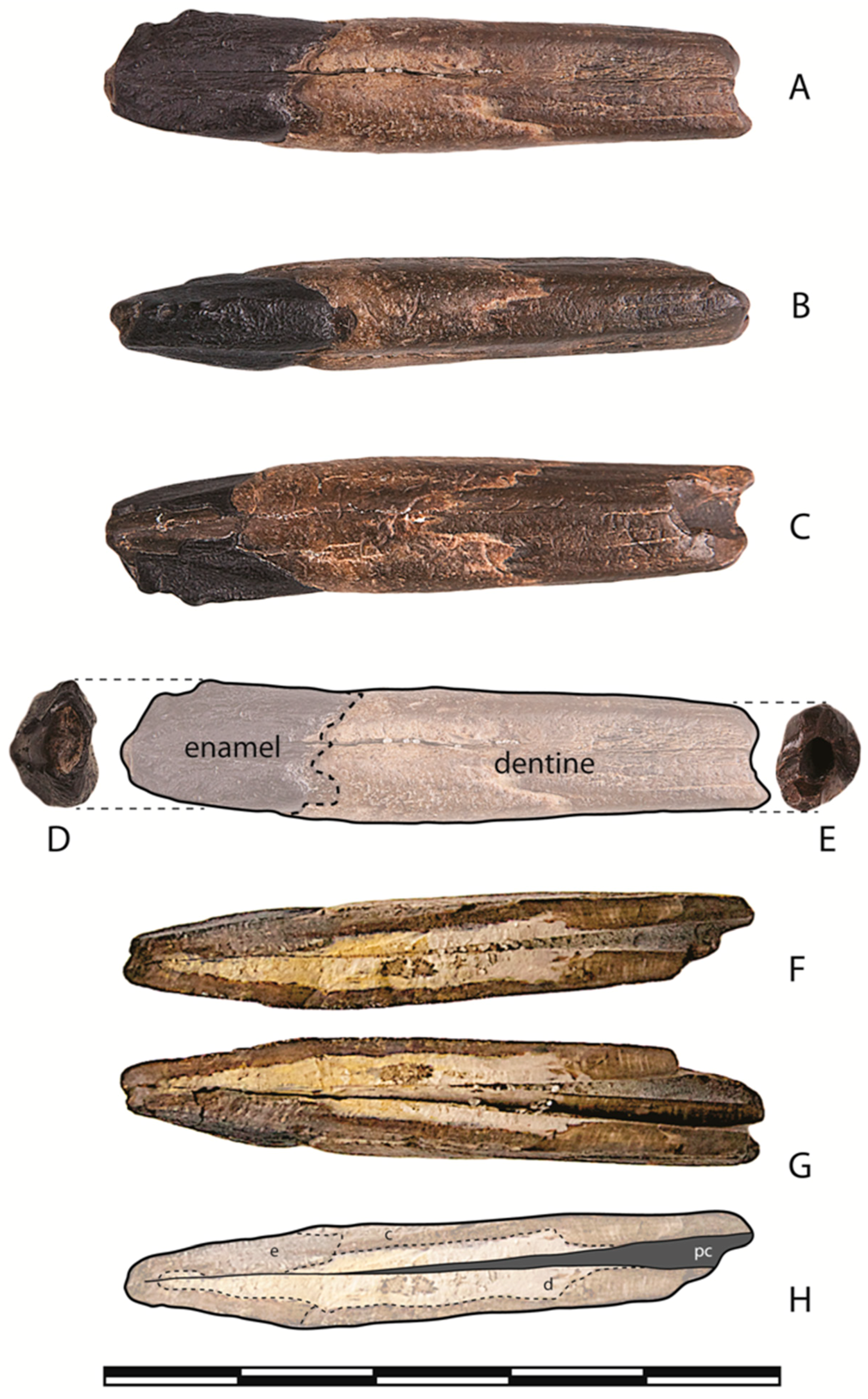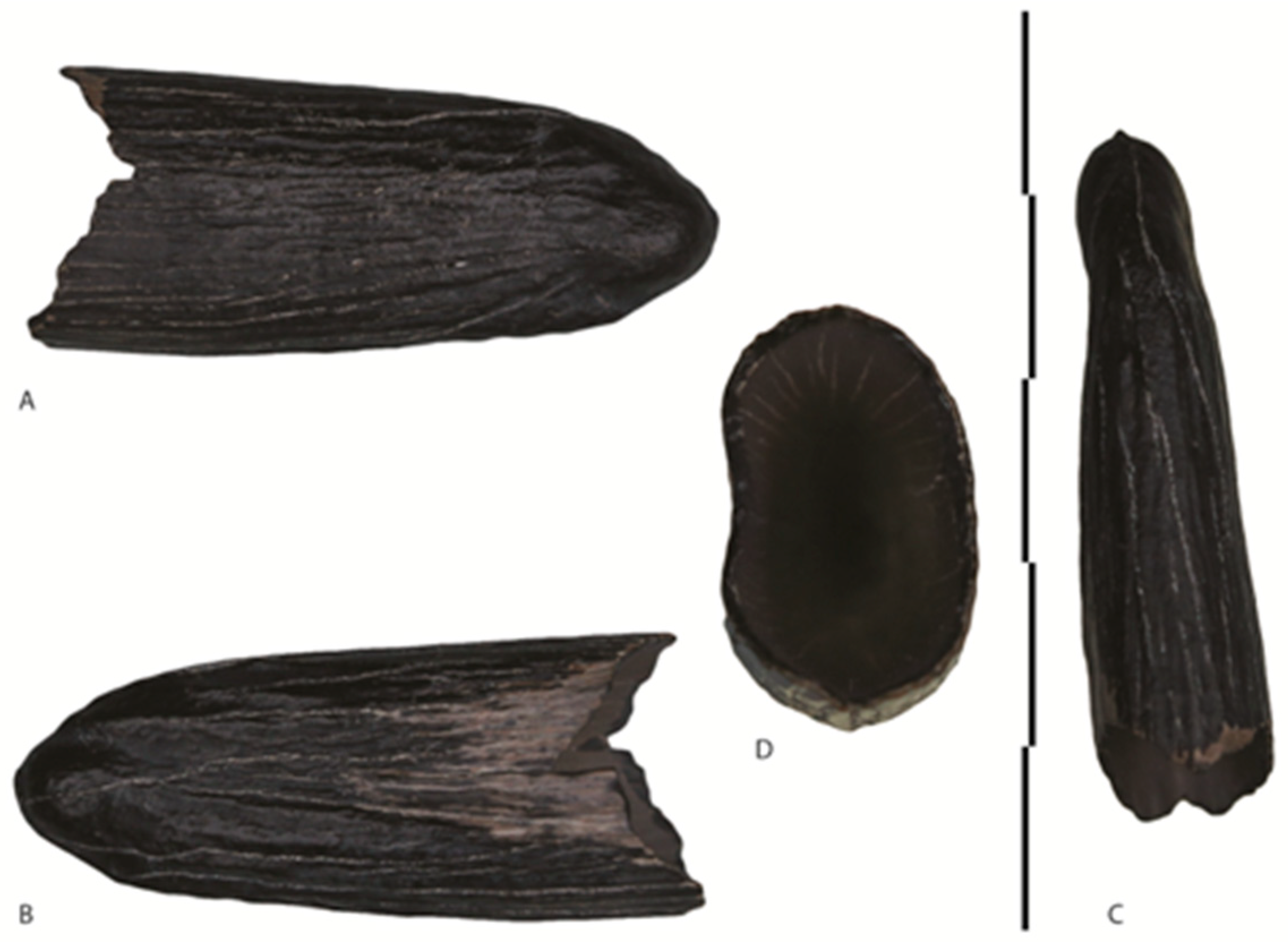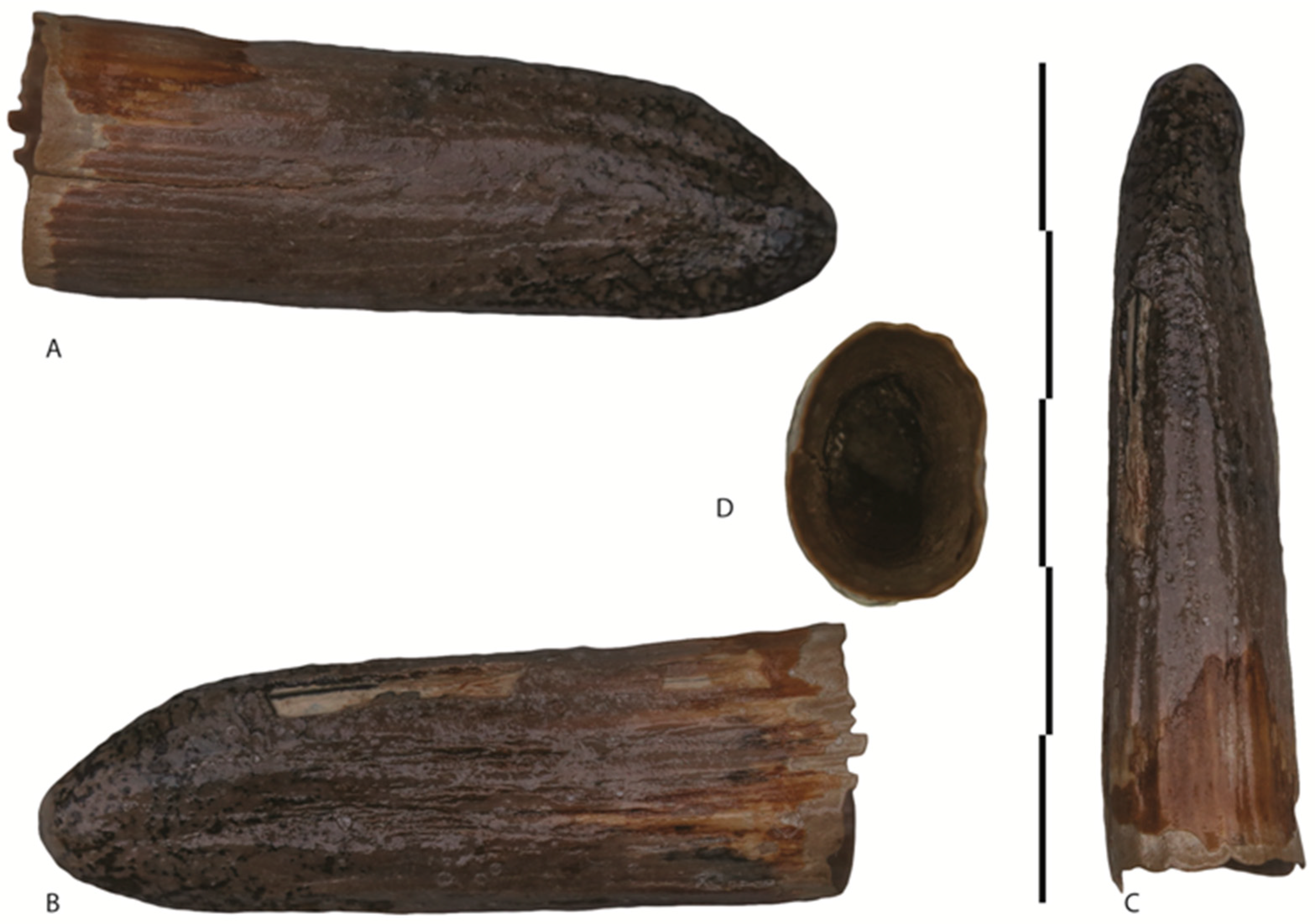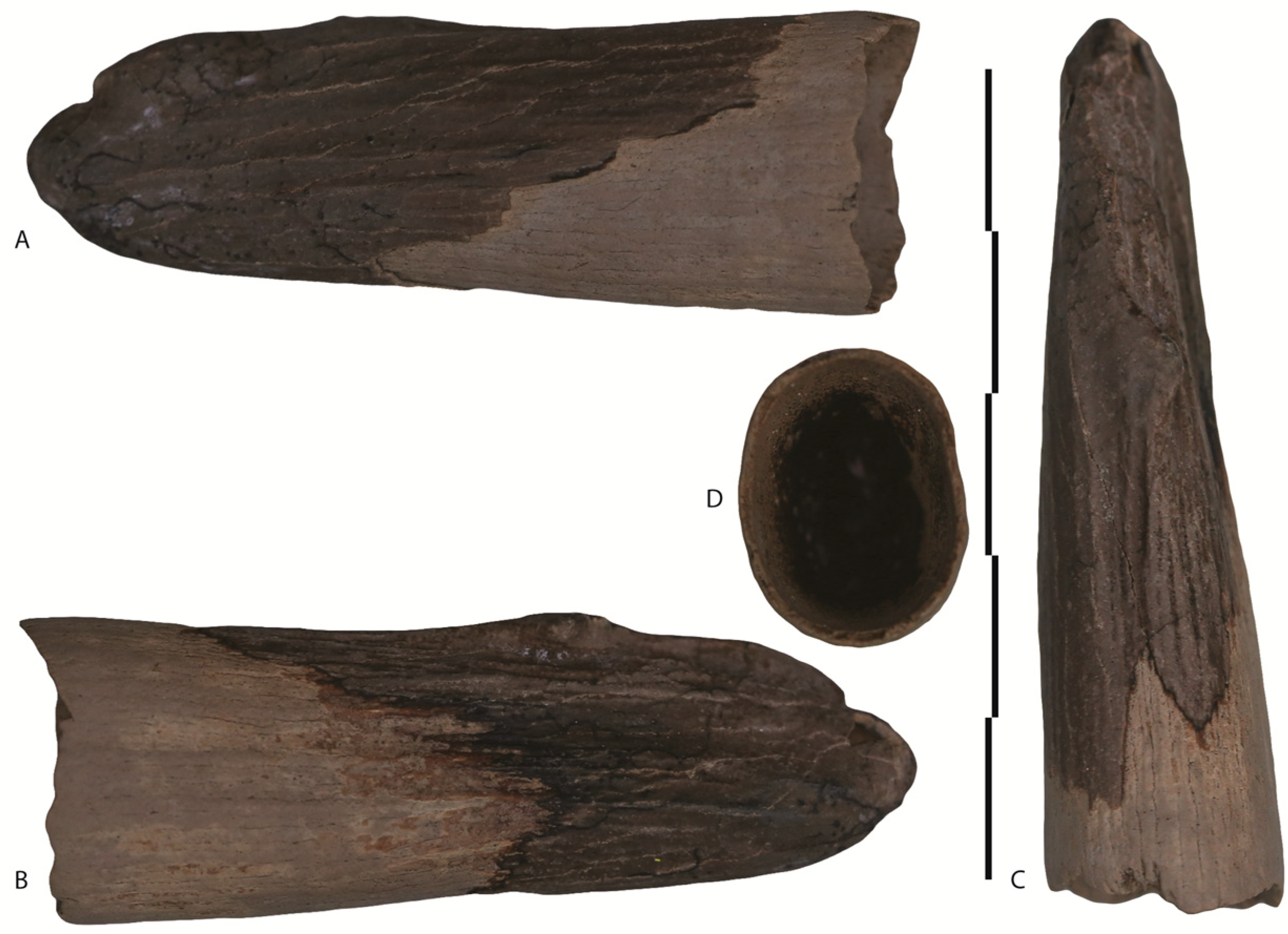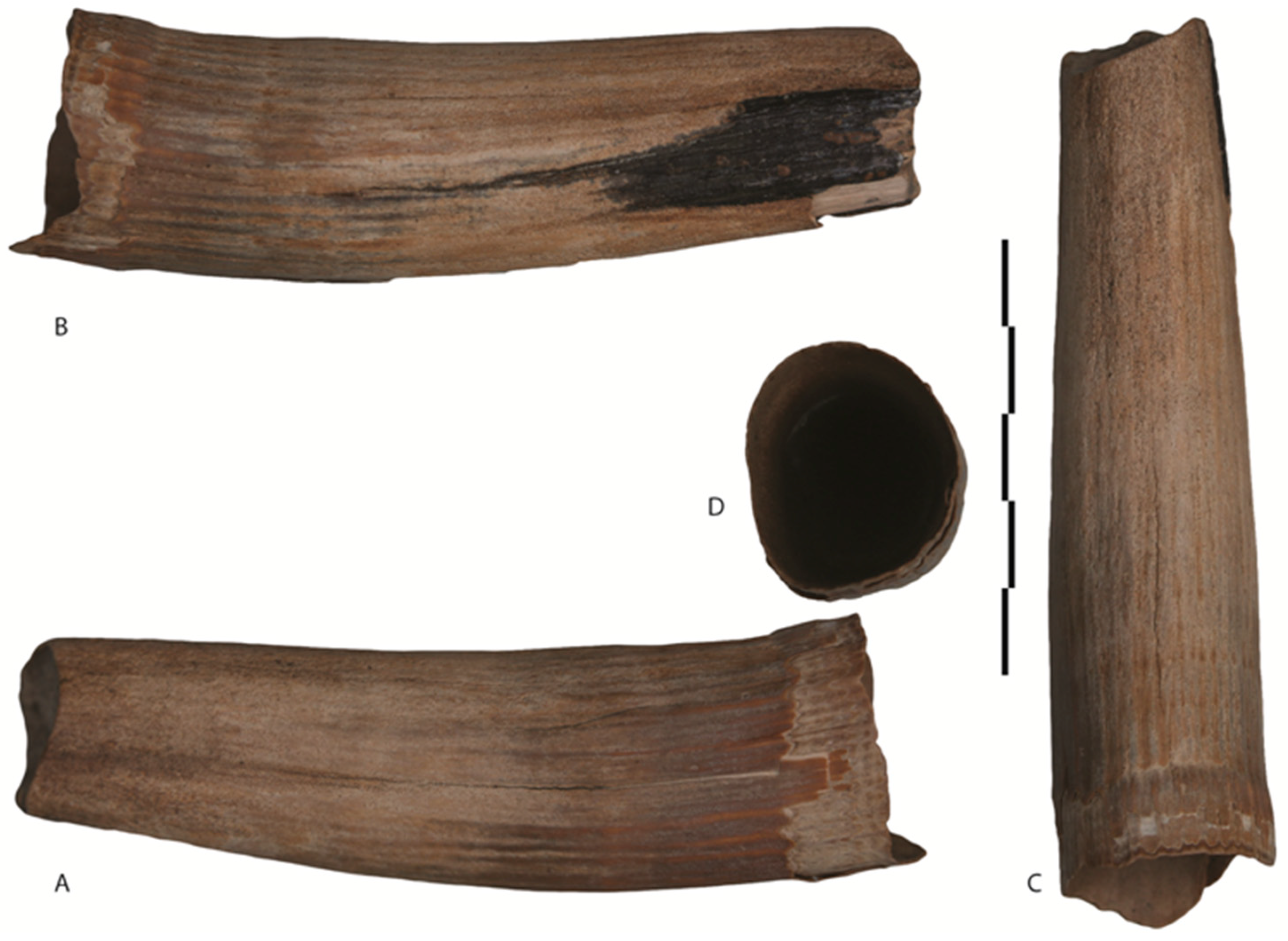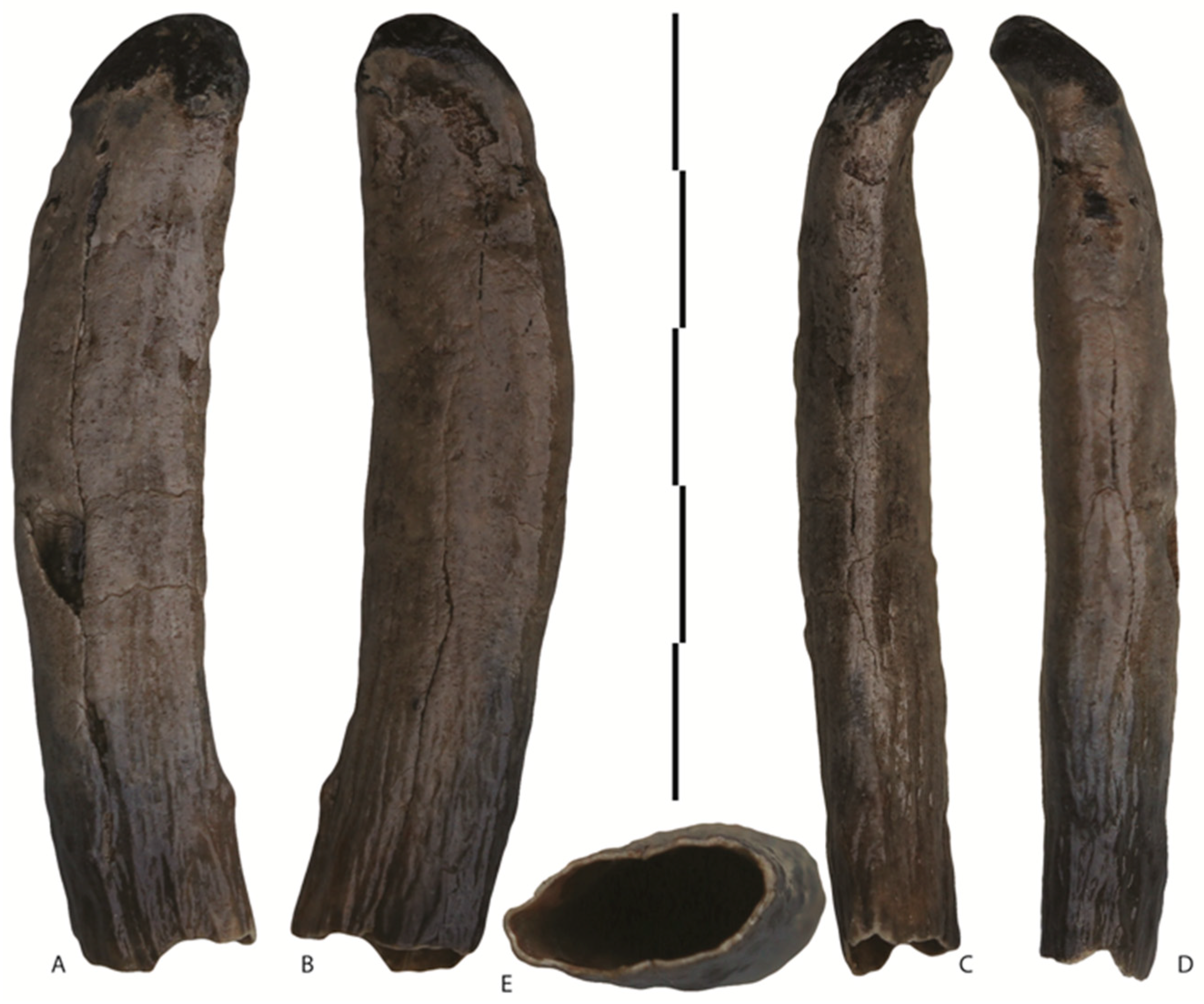1. Introduction
The North Sea floor, located between the British Isles and the continent of Europe, is an important source of fossil mammal remains from the entire Quaternary [
1]. Several mammalian faunas inhabited the area during various episodes of the Pleistocene. The terrestrial mammals from the North Sea are divided into four fauna-associations which are regarded as groups of larger mammals with a comparable age, although not necessarily regarded as contemporaneous [
2].
The oldest, Early to Middle Pleistocene Fauna-associations I and II, contain heavily mineralized and very dark fossils including the proboscideans Anancus arvernensis (Croizet and Jobert, 1828), Mammuthus meridionalis (Nesti, 1825) and Mammuthus trogontherii (Pohlig, 1885). Fauna-association III is much younger, of Late Pleistocene age, with Elephas antiquus (Falconer and Cautley, 1847) and Mammuthus primigenius. The bulk of the radiocarbon dates fall within Maritime Isotope Stage 3 (57–29 Ka cal BP). Fauna-association IV is Holocene, and does not contain any remains of proboscideans.
The fossils of these mammals have routinely been brought up in the nets of fishing vessels such as beam trawlers [
3,
4]. One of the best known and richest sources of fossils in the Southern Bight of the North Sea is the Eurogeul area off the coast of the province of South Holland. These fossils are found in fluvial sediments deposited in the former deltas of the Rhine and Meuse Rivers, before they were flooded by rising sea levels at the end of the last ice age [
5,
6]. The Eurogeul, or Eurogully, is a channel for large ships to enter the ports of Rotterdam (the Euro-Meuse channel). This channel fills in with sediment, which must routinely be removed to maintain an adequate channel depth for the passage of ships. The fossil-rich sediments are dredged and deposited along the coastline of The Netherlands, which reinforces and extends the beaches. The same process is used for the construction of Maasvlakte 2, an artificial extension of the Rotterdam harbor (
Figure 1). This results in the creation of new localities where the remains of Pleistocene and Holocene animals may be discovered.
In recent years, many private collectors have created collections of various fossils found on the seashore. These beaches are a rich source of well-preserved skeletal parts of large terrestrial mammals such as woolly mammoths and woolly rhinoceroses of the mammoth fauna. However, remains of small terrestrial, marine, and freshwater aquatic mammals such as beavers and otters have also been collected. Other interesting finds include insect remains, birds, fish, and even coprolites of hyenas [
7,
8,
9,
10,
11,
12,
13,
14]. These fossil finds are often well documented, and reveal many previously unknown details about the individuals and their species, as well as their habitat and faunal assemblages. Through amateur beach collecting, important insights have been made for the deciduous and the very small permanent tusks of woolly mammoths. Little was known about these deciduous tusks and the early development of the permanent tusks of these proboscideans.
The juvenile deciduous and permanent tusks described here are identified as belonging to the late Pleistocene-age
Mammuthus primigenius, based on their morphology [
15,
16,
17]. Early and middle Pleistocene faunal remains from the bottom of the North Sea can easily be distinguished from late Pleistocene remains by their heavily mineralized state of preservation [
1,
8,
9,
18].
2. Literature Review for Deciduous and Permanent Tusks
Several publications describe details about deciduous and permanent tusks of
Mammuthus primigenius [
10,
15,
16,
17,
19,
20]. However, the number of reported specimens is limited.
Rountrey et al. [
17] stressed the importance of finding additional tusk specimens in their landmark research on early tooth development, gestation, and season of birth in mammoths regarding these dental elements. In their conclusion they stated:
This work shows the potential value of detailed individual life history studies using teeth. With work on additional specimens, these techniques could lead to construction of an accurate tooth development schedule for mammoths, and this information is critical for studies of mammoth life history that will help elucidate ecological factors associated with extinction.
Every find of deciduous tusks and small permanent tusks of extremely young mammoths can contribute greatly to our scientific understanding in this area of study, and should be recorded. Hence, the amateur collectors of fossil remains on Dutch beaches deserve support and should be encouraged both to learn to recognize these rare specimens and to have opportunities to present them to paleontologists for examination. This paper intends to contribute to this effort, with a short overview of the literature and a discussion of both the known deciduous tusks and the smallest permanent tusks of juvenile mammoths from the environment of The Netherlands, which have been identified in recent years.
There are other dental elements and parts thereof that can be easily confused with the smallest tusks. One of these confounding fossils is presented here, a fossil
digitelle (“finger”) of a plate of a premolar of a juvenile woolly mammoth, which was considered to be a possible small tusk. Mammoths and modern elephants go through a series of six sets of adult molars in their lifetime. The molars are classified with capital letters for upper molars and lower case letters for lower jaw molars (
Table 1).
Recognizing and determining fossils to species level requires comparison with known specimens. Because of the rarity and the difficulty in recognizing the deciduous and juvenile permanent tusks of
Mammuthus primigenius, the fossil record is very limited. Sikes [
21] discussed details about these teeth from the African elephant,
Loxodonta africana (Blumenbach, 1797), providing useful specimens for comparison. Mashchenko [
15] described several of these juvenile tusks, and concluded that both deciduous tusks and permanent tusks develop in the fetus during the earliest stages simultaneously and that the former were merely rudimentary without any function, being quickly replaced by the permanent tusks.
Rountrey et al. [
17] published a detailed analysis of two extraordinary late Pleistocene juvenile mammoth mummies from Siberia, giving a comprehensive description of their dental elements. One complete mummy was Lyuba from Yamal, a female individual who died when she was one month old. Remarkably, she was missing both permanent tusks. The other was Oimyakon from Yakutia, a partial mummy with the right permanent tusk, the left one being lost. Its gender is unknown and it was approximately seven months old at time of death. It had already lost the deciduous tusks, described and photographed by Maschenko et al. [
16]. In cross-section, the oval-shaped permanent tusk measured 76 mm in length and was entirely covered with cementum and characterized by the tip of the tusk being covered with an enamel cap.
Van der Plicht et al. [
10] described a somewhat larger juvenile skull with a right permanent tusk still anchored in the alveolus. This skull was trawled from the North Sea floor in the Eurogeul. It is mentioned here to illustrate the typical black enamel, which eventually becomes worn down due to usage (
Figure 2). These publications are useful references for identifying and analyzing these rare dental elements.
3. Review of Deciduous and Permanent Tusk Collections in The Netherlands
The following is a brief overview of all known fossil deciduous and permanent tusks of Mammuthus primigenius in or close to The Netherlands.
3.1. Terra Maris Museum Collection in Oostkapelle
A deciduous tusk in the collection of the Museum Terra Maris (Oostkapelle) was found on a trail consisting of sea shells in Zeeland near Veere in the late 1980s. The very small and fragile specimen shows the typical well-developed root and has been described by Langeveld and Mol [
22]. It belonged to a very young
Mammuthus primigenius, probably only a couple of months old at the time of its death.
3.2. Collection of Jan van der Steeg
A perfectly preserved deciduous tusk was found in the Holt-und-Haar sand pit, close to Gildehaus in Germany near the Dutch border. It is catalogued as number P00170 in the collection of Jan van der Steeg in Losser. Meijer [
23] provided more details about the site and its mammalian fauna. The entire specimen is somewhat club shaped has a very weak S-curve. The specimen was described and photographed by Mol and Boeskorov [
24]. No traces of wear are visible, indicating that it must have been embedded entirely in the alveolus. Mol and Boeskorov [
24] suggested that this animal must have died before the age of one year. The tusk measures 69.9 mm in length. The tip is covered with a thin enamel layer which in turn is covered by a very thin layer of cementum. The diameter of the enamel cap is between 7.1 and 14 mm.
3.3. Collection of Walter Langendoen
Another right deciduous tusk of a
Mammuthus primigenius was collected on May 2014 on the man-made beach of Maasvlakte 2 and added as specimen number WL0181 to the collection of Walter Langendoen (
Figure 3). It is currently on display in the Historyland museum in Hellevoetsluis. Mol et al. [
9], Langeveld and Mol [
22] and Mol [
18] described this small deciduous tusk, which was reasonably well preserved. Its tip consists of dentin covered by a cap of enamel. The root is damaged in the area of the pulp cavity and the exact original length cannot be determined. This specimen is practically straight and has a preserved length of 46 mm. The enamel cap’s length is 17 mm and its diameter varies between 6 and 9 mm.
The original tusk was used to make some casts. Unfortunately, it broke in half along the length of the axis during the production of the casting mold. However, this accident provided insight in the interior, which shows the different tooth tissues clearly indicating dentin, cementum and enamel. The depth of the still-open pulp cavity, the volume of dentin and the cementum and enamel cover are visible in
Figure 3H. The tusk was eventually restored.
3.4. Collection of Peter Soeters
A complete right deciduous tusk was found on the beach of Rockanje (South Holland Province) in May 2008 and it was added to the collection of Peter Soeters in Delft (
Figure 4). Its root is somewhat curved and has a rather small pulp cavity. The tusk is slightly incurvate as well and has a pristine cap of black enamel. It has a shallow, weakly-developed groove on the medial side. The maximum length is 52 mm and the thickness is 6 mm measured in the middle of the flattened root. The crown has a lateral length of 9 mm and a medial length of 7 mm.
3.5. Collection of Donny Chrispijn
A complete right deciduous tusk was found by Peter Soeters on the beach of Rockanje in April 2008, and it was added to the collection of Donny Chrispijn in Hoek van Holland (
Figure 5). The typical groove is visible on the medial side, facilitating the determination. The smaller length compared to the specimen in
Section 3.4 is noted, which is probably due to resorption in the growing process of the permanent tusk behind it. The original length must have been distinctly longer. This would also mean that the permanent tusk was present during the first year of the calf’s life [
16]. Sikes [
21] also described this growing process for African elephants. The maximum length of this specimen is 37 mm and the thickness is 7 mm measured in the middle of the flattened root. The crown has almost the same dimensions as in
Section 3.4, has a lateral length of 9 mm and a medial length of 7 mm. The enamel cap is well preserved and its width is 12 mm laterally and 11 mm medially.
3.6. Collection of Hansjorg Ahrens
Hansjorg Ahrens from Leiden collected a small permanent right tusk of a very young woolly mammoth on the beach of De Zandmotor, which is an artificial extension of the coastline at the coast of Monster (South Holland Province). Except for a small indentation on the pulp cavity, the tusk is in superb state of preservation (
Figure 6). The tusk is straight and slightly flattened giving an oval cross-section. It is covered in a thin film of black enamel with the exception of a small section of the medial side which is tan colored. The lateral and medial surface of this tusk is rough due to a thin irregular layer of enamel. The typical groove is visible on the medial side. This permanent tusk belonged to an unborn or newborn individual. It is the smallest known specimen with a maximum length of 37 mm. The depth of the pulp cavity is 22 mm. The maximum circumference at the base of the pulp cavity is 43 mm; the diameter is 16 mm, and it measures 9 mm from the axis to the lateral side.
3.7. Collection of Dick Mol
Peter Soeters from Delft collected a permanent tusk of a juvenile woolly mammoth on the beach of Rockanje in August 2013, which he then donated to the first author. This well preserved tusk is straight with no curvation (
Figure 7). It also shows the characteristic groove indicating that it originated from the left upper jaw. Most of this gray-brown to yellow-brown specimen is covered with a wafer-thin layer of enamel. When compared to the specimens described by Machenko [
15], it can be concluded that the animal was only a few months old when it died. The maximum length is 49 mm. The depth of the pulp cavity measures 24 mm. Posterior of the pulp cavity, the circumference of the tusk is 48 mm. Measured from the back to the front, the diameter here is 17 mm, and measures 12 mm from medial to lateral.
3.8. Collection of Willy van Wingerden
On 24 February 2017, Willy van Wingerden from Honselersdijk picked up a permanent tusk of a woolly mammoth from the beach of De Zandmotor. The shape of the tusk is straight (
Figure 8). The tip is covered with a thin layer of enamel and the transition from the enamel to the dentin is clearly visible. The previously described groove located on the medial side of the tusk facilitates the determination as a left permanent tusk. The tusk is tan colored and the enamel tends to a dark brown color. Resembling the specimen from Dick Mol’s collection found on the beach of Rockanje (Item 3.7), this tusk must have belonged to a juvenile
Mammuthus primigenius just a couple of months old. The maximum length is 53 mm and the pulp cavity is 21 mm deep.
3.9. Collection of Martien Lelij
A superb specimen of a permanent tusk of a woolly mammoth was found by the late Martien Lelij from Hoek van Holland on the local beach in March 2012. It is a tusk from the upper right jaw and it is slightly curved (
Figure 9). It clearly has the characteristic groove on the medial side. The brown to dark brown enamel layer is substantial in thickness. The cementum layer and the transition from the cementum to the dentin are clearly visible. Because the tip of this tusk is not yet polished due to use, it is likely that it was completely hidden in the alveolus of the living animal. If so, it would imply that this tusk belonged to a woolly mammoth that must have died within the first year of its life. This undamaged tusk has a length of 102 mm. At the end of the pulp cavity, the circumference of the tusk is 55 mm. The diameter of the oval pulp cavity is 19 mm at maximum. The enamel layer measures from the tip of the tusk to the rear over a maximum length of 66 mm.
3.10. Collection of Trudy Langeveld
A right permanent juvenile tusk was collected by Trudy Langeveld from Voorhout in January 2011 on the beach of Hoek van Holland. The sand originated from the extraction areas to the north of the Euro-Maasgeul, off the coast of South Holland. It has been added to her collection under catalog number 141.
This larger specimen, mostly yellow-brown colored, is slightly damaged; the tip has been broken recently, possibly due to the suction action of the sand dredging machine (
Figure 10). It is slightly rounded medially, showing the characteristic groove. Deposits of wafer-thin black enamel are still present on the lateral side of this tusk. The marks of this permanent tusk suggest that it had already emerged from the tusk socket and must have been visible in the living animal. When compared to the specimen described by Van der Plicht et al. ([
10] see
Figure 2) it can be concluded that the animal was 12–24 months old at time of death. The specimen has a preserved length of 102 mm, but reconstructing the total length using the specimen from the collection of Martien Lelij for comparison, at least 30 mm is missing. The depth of the pulp cavity is 84 mm and its maximum diameter measures 28 mm.
3.11. Collection of Henk Mulder
In November 2017, Henk Mulder from Monster picked up a left permanent tusk of a young woolly mammoth from the beach of De Zandmotor. Unfortunately, the tip of the tusk was broken due to mechanical action. However, the pulp cavity was intact. This tusk was from an older individual than the specimen from the collection of Trudy Langeveld (Item 3.10). The length is about 150 mm and the depth of the pulp cavity is 55 mm.
4. The Juvenile Tusk Look-Alike
The preceding text gives an overview of known deciduous tusks and permanent tusks of very young woolly mammoths. The knowledge is valuable as a reference collection, and also to distinguish them from confounding elements that look similar but yet have a different origin; in particular, the following dental element.
Erwin van der Lee found a fragment of a dental element in the supplemented sand of the beach of Hoek van Holland in August 2017 (
Figure 11). The specimen has some characteristics of a tusk of a juvenile mammoth. It is fragile, not fully developed, without a root and a very deep pulp cavity. The maximum length is 46 mm. It appears to be complete, from the pulp cavity on the posterior side to the tip on the anterior side. It is slightly curved and strongly flattened laterally. The tip is covered by a thin cap. The circumference of this tusk is 28 mm at the pulp cavity and 26 mm in the middle of the tusk. The depth of this cavity appears to be 22 mm. The specimen consists of dentin completely covered with a film of enamel, which in turn is covered by a thin layer of cementum. The cross-section of the dental element is flattened, giving an oval shape over the entire length. The maximum diameter of the tusk, measured from front to back is 5 mm, in anatomical position. It measures 10 mm from medial to lateral. The pulp cavity is extremely small compared to all known small permanent tusks. Moreover, this specimen is too flattened, seen from front to back. These are not characteristics of newly-developed permanent tusks. Furthermore, the morphology of the find is too irregular in structure to be determined as a (permanent) tusk.
This specimen must be identified as one of the digitelles, which is a part of lamella of a mammoth molar. A pillar or a slat shows deep incisions. It appears that such a pillar is composed of several adjacent, and, on the bottom, closely connected digits that are flattened from the front to the rear. Such a pillar is made up of several varying digitelles. Several digits and the pillars form a plate. The digits are usually connected at the base. This is not always the case with premolars. The size of this digitelle suggests that this must have been part of a third or fourth premolar.
5. Conclusions
The tusks of juvenile Mammuthus primigenius discussed in this paper are of great scientific value as they are still very rare in the fossil record. Because of sand supplementation activities of the Dutch beaches, deciduous tusks and very small permanent tusks are now occasionally found. These elements are very important sources for mammalian paleontological research. However, the chance of recognition is also slim. The tusks described and illustrated here can aid in recognition of these particular mammoth remains and increase the likelihood that they will be preserved for the fossil record.
5.1. Basic Characteristics of Deciduous Tusks
A deciduous tusk is somewhat club shaped and has a relatively large root and a well-developed cap on the tip, which is covered with a thin enamel layer that in turn is covered by a thin layer of cementum. It may measure around 35–100 mm in length and usually nearly straight or only slightly nonlinear. The cross-section is more or less oval shaped—the lateral side being more curved than the medial side. A shallow groove may be visible on the medial side of the tusk (
Figure 3A,
Figure 4A,
Figure 5A,
Figure 6B,
Figure 7B,
Figure 8B,
Figure 9B and
Figure 10A).
5.2. Basic Characteristics of Juvenile Permanent Tusks
The major distinction between the deciduous and permanent tusk is the relatively deep pulp cavity, which may measure up to about half of its total length. Permanent tusks do not have a root. The length of the smallest known specimen measures 37 mm and it is covered with a very thin layer of enamel. The common features with deciduous tusks are the cross-section, the lateral side being more curved compared to the medial side. The medial side of the tusk is characterized by a shallow groove. However, a correct identification of fossil remains requires careful comparisons. To determine whether the specimen is a deciduous tusk or a newly-developed permanent tusk, a thorough knowledge is required of the tusk and the development of proboscideans. It was only after extensive comparisons that the discovery of Erwin van der Lee could be definitively classified as a digitelle of a lamella or plate of a Mammuthus primigenius, rather than a juvenile tusk.
Tusks of proboscideans have a complex structure with chevron shaped lines (Schreger lines) and growth rings much like trees, which carry the complete life history. A detailed analysis of a tusk’s interior would provide more information about the first years of life of mammoths which inhabited the vast plains between the British Isles and the continent of Europe in the Late Pleistocene. Then, we might be able to judge the rate at which newborn mammoth calves have grown, and whether or not that matches what we know about elephants in Africa and Asia. Hopefully, more such finds will be made in sufficient quantities to sacrifice one or more of good quality to be subjected to the required destructive tests for that.
Author Contributions
The authors all contributed to the determinations, to the analysis of the results and to the writing of the manuscript.
Funding
No funding was received for the production of this paper.
Acknowledgments
The authors would like to express their gratitude to Erwin van der Lee from Rotterdam for making available his discovery of the digitelle of a premolar woolly mammoth for identification and research. Once more, we would like to thank Jan van der Steeg in Losser and Walter Langendoen in Hellevoetsluis, for making available the deciduous tusks in their care; Peter Soeters in Delft for his donation of a number of mammoth finds, including the very small permanent tusk; the late Martien Lelij from Hoek of Holland, Hansjorg Ahrens from Leiden, Trudy Langeveld from Voorhout, Henk Mulder from Monster, Donny Chrispijn from Hoek van Holland and Willy van Wingerden from Honselersdijk for providing their exceptional finds of very small permanent tusks for description; Hans Wildschut, Hoofddorp, for the photography; and Klaas Post and Bram Langeveld (Natuurhistorisch Museum Rotterdam) for reviewing earlier drafts of this paper.
Conflicts of Interest
The authors declare no conflict of interest.
Ethical Statement
In The Netherlands, collecting fossils from public places is legal. However, fossil collection elsewhere may be limited or prohibited by law. Also none of the authors are a member of any professional society with a code of ethics that recommends against publishing work on specimens that are held in private collections. Such a code would be counterproductive in The Netherlands. The vast public beaches contain an abundance of small fossil remains. Over the years, the number of non-professional paleontologists has increased steadily, and they may have collected many rare specimens that would not have been discovered otherwise. Non-professionals are a valuable resource to the field of paleontology here. In the Netherlands we are facing a unique situation. For almost four decades, professionals and non-professionals have been united in the active Werkgroep Pleistocene Zoogdieren (working group Pleistocene Mammals,
www.pleistocenemammals.com), which organizes very well attended fossil determination sessions several times a year for their ever-increasing collections. At these meetings, non-professionals can learn and have their fossil finds identified by professionals. The professional scientific community benefits from these meetings in getting an overview of all the discoveries made in the field. Knowledge and information is shared mutually. In this way, many rare specimens have emerged, enriching the Pleistocene fauna of the North Sea. Often these collectors develop an interest in the whereabouts of their finds and many educate themselves to become ‘citizen scientists’. In addition, the collectors are encouraged to donate or loan their specimens to museums for availability for research. Moreover, replicas are routinely produced for display. Most collectors are happy to have their specimens examined by scholars. Publicizing about these noteworthy finds in leading international media is a logical part of this process.
References
- Mol, D.; de Vos, J.; Bakker, R.; van Geel, B.; Glimmerveen, J.; van der Plicht, J.; Post, K. Kleine Encyclopedie Van Het Leven in Het Pleistoceen—Mammoeten, Neushoorns en Andere Dieren van de Noordzeebodem; Uitgeverij Veen Magazines B.V.: Diemen, The Netherlands, 2008; ISBN 9789085710981. [Google Scholar]
- Van Kolfschoten, T.; Laban, C. Pleistocene terrestrial mammal faunas from the North Sea. Meded. Rijks Geol. Dienst 1995, 52, 135–151. [Google Scholar]
- Mol, D. Twee etmalen korren in de Eurogeul: trok de kotter OD7 door een mammoetkerkhof? Afzettingen 2012, 33, 7–10. [Google Scholar]
- Mol, D.; Post, K. Gericht korren op de Noordzee voor de zoogdierpaleontologie: Een historisch overzicht van de uitgevoerde expedities. Cranium 2010, 2, 14–28. [Google Scholar]
- Laban, C.; Rijsdijk, K.F. De Rijn-Maasdelta’s in de Noordzee. Grondboor Hamer 2002, 56, 60–65. [Google Scholar]
- Rijsdijk, K.F.; Kroon, I.C.; Meijer, T.; Passchier, S.; van Dijk, T.A.G.P.; Bunnik, F.P.M.; Janse, A.C. Reconstructing Quaternary Rhine–Meuse dynamics in the southern North Sea: Architecture, seismolithofacies associations and malacological biozonation. J. Quat. Sci. 2013, 28, 453–466. [Google Scholar] [CrossRef]
- Post, K. A Weichselian marine mammal assemblage from the southern North Sea. Deinsea 2005, 11, 21–27. [Google Scholar]
- Mol, D.; Borst, W.; Reumer, J. De eerste fossiele hyenakeutel uit de Noordzee. Straatgras 2010, 22, 91–93. [Google Scholar]
- Mol, D.; Langeveld, B.; Janse, A.; Langendoen, W.; Smolarz, J. Determinatiedag fossiele strandvondsten van Maasvlakte 2 in Futureland: Een verslag. Cranium 2015, 32, 49–58. [Google Scholar]
- Van der Plicht, J.; Post, K.; Mol, D. Over aasvliegen en een mammoetkalf uit de Eurogeul. Cranium 2012, 29, 14–19. [Google Scholar]
- Dieleman, F. Overzicht van strandvondsten van woelmuizen en andere kleine zoogdieren langs de Nederlandse stranden: Stand van zaken 2013. Afzettingen 2013, 34, 144–172. [Google Scholar]
- Langeveld, B. Trogontherium cuvieri Fischer (Castoridae) van het strand van Hoek van Holland en de Zandmotor. Cranium 2013, 30, 8–12. [Google Scholar]
- Langeveld, B. Fossiele omhulsels van poppen van de subarctische aasvlieg Protophormia terraenovae Robineau-Desvoidy, 1830 voor het eerst van opgespoten stranden (Eurogeulgebied). Cranium 2015, 32, 34–38. [Google Scholar]
- Langeveld, B. Vondsten van de reuzenalk Pinguinus impennis (Linnaeus, 1758) (Aves) uit het Eurogeulgebied. Cranium 2015, 32, 19–27. [Google Scholar]
- Maschenko, E.N. Individual development, biology and evolution of the woolly mammoth. Cranium 2002, 19, 4–120. [Google Scholar]
- Maschenko, E.N.; Boeskorov, G.G.; Baranov, V.A. Morphology of a Mammoth Calf (Mammuthus prinigenius) from Ol’chan (Oimiakon, Yakutia). Paleontol. J. 2013, 47, 425–438. [Google Scholar] [CrossRef]
- Rountrey, A.N.; Fisher, D.C.; Tikhonov, A.N.; Kosintsev, P.A.; Lazarev, P.A.; Boeskorov, G.; Buigues, B. Early tooth development, gestation, and season of birth in mammoths. Quat. Int. 2012, 255, 196–205. [Google Scholar] [CrossRef]
- Mol, D. Mammoth fossils recovered from the seabed between the British Isles and the European continent. Bulletin de Musée d’Anthropologie préhistorique de Monaco 2016, 6, 129–142. [Google Scholar]
- Maschenko, E.; Tikhonov, A.N.; MacPhee, R.D. Mammoth calf from Bolshoi Lyakhovskii Island (New Siberian Islands, Arctic Siberia). Russ. J. Theriol. 2005, 4, 79–88. [Google Scholar] [CrossRef]
- Maschenko, E.N.; Gablina, S.S.; Tesakov, A.S.; Simakova, A.N. The Sevsk woolly mammoth (Mammuthus primigenius) site in Russia: Taphonomic, biological and behavioral interpretations. Quat. Int. 2006, 142, 147–165. [Google Scholar] [CrossRef]
- Sikes, S.K. The Natural History of the African Elephant; World Naturalist; Weidenfeld and Nicolson: London, UK, 1971; pp. 1–397. ISBN 978-0297000297. [Google Scholar]
- Langeveld, B.; Mol, D. Vanuit de zeebodem naar het strand: Een kennismaking met fossielen van Maasvlakte 2 (deel 1). Spirifer 2015, 39, 2–19. [Google Scholar]
- Meijer, H.J.M. Mammoeten moeten ook drinken. Een nieuwe visie op een Laat-Pleistoceen ecosysteem. Cranium 2001, 18, 17–26. [Google Scholar]
- Mol, D.; Boeskorov, G. Een merkwaardige slagtand van een wolharige mammoet, Mammuthus primigenius (BLUMENBACH, 1799) uit de Noordzee en korte beschrijvingen van twee mammoettanden uit Europa en Azië, met algemene opmerkingen over slagtanden. Cranium 2007, 24, 17–36. [Google Scholar]
© 2018 by the authors. Licensee MDPI, Basel, Switzerland. This article is an open access article distributed under the terms and conditions of the Creative Commons Attribution (CC BY) license (http://creativecommons.org/licenses/by/4.0/).
